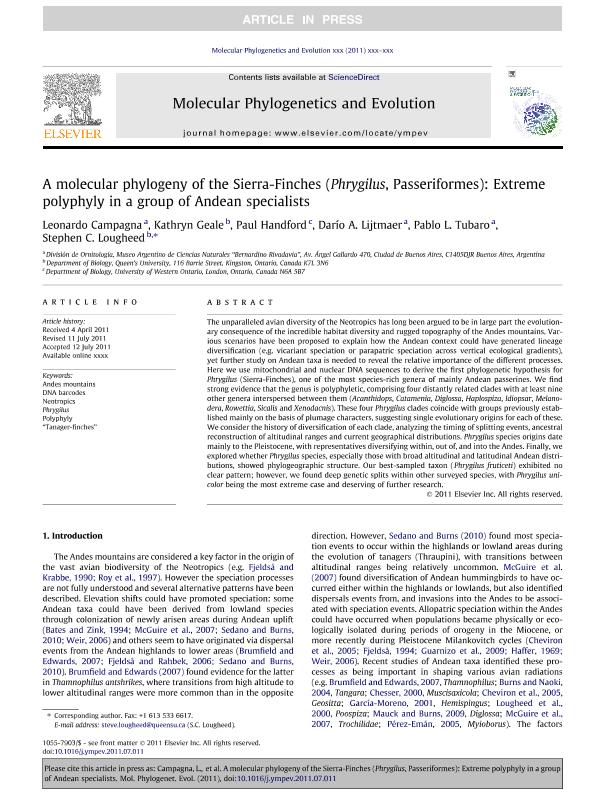Artículo
A molecular phylogeny of the Sierra-Finches (Phrygilus, Passeriformes): Extreme polyphyly in a group of Andean specialists
Campagna, Leonardo ; Geale, Kathryn; Handford, Paul; Lijtmaer, Dario Alejandro
; Geale, Kathryn; Handford, Paul; Lijtmaer, Dario Alejandro ; Tubaro, Pablo Luis
; Tubaro, Pablo Luis ; Lougheed, Stephen C.
; Lougheed, Stephen C.
 ; Geale, Kathryn; Handford, Paul; Lijtmaer, Dario Alejandro
; Geale, Kathryn; Handford, Paul; Lijtmaer, Dario Alejandro ; Tubaro, Pablo Luis
; Tubaro, Pablo Luis ; Lougheed, Stephen C.
; Lougheed, Stephen C.
Fecha de publicación:
11/2011
Editorial:
Academic Press Inc Elsevier Science
Revista:
Molecular Phylogenetics and Evolution
ISSN:
1055-7903
Idioma:
Inglés
Tipo de recurso:
Artículo publicado
Clasificación temática:
Resumen
The unparalleled avian diversity of the Neotropics has long been argued to be in large part the evolutionary consequence of the incredible habitat diversity and rugged topography of the Andes mountains. Various scenarios have been proposed to explain how the Andean context could have generated lineage diversification (e.g. vicariant speciation or parapatric speciation across vertical ecological gradients), yet further study on Andean taxa is needed to reveal the relative importance of the different processes. Here we use mitochondrial and nuclear DNA sequences to derive the first phylogenetic hypothesis for Phrygilus (Sierra-Finches), one of the most species-rich genera of mainly Andean passerines. We find strong evidence that the genus is polyphyletic, comprising four distantly related clades with at least nine other genera interspersed between them (Acanthidops, Catamenia, Diglossa, Haplospiza, Idiopsar, Melanodera, Rowettia, Sicalis and Xenodacnis). These four Phrygilus clades coincide with groups previously established mainly on the basis of plumage characters, suggesting single evolutionary origins for each of these. We consider the history of diversification of each clade, analyzing the timing of splitting events, ancestral reconstruction of altitudinal ranges and current geographical distributions. Phrygilus species origins date mainly to the Pleistocene, with representatives diversifying within, out of, and into the Andes. Finally, we explored whether Phrygilus species, especially those with broad altitudinal and latitudinal Andean distributions, showed phylogeographic structure. Our best-sampled taxon (Phrygilus fruticeti) exhibited no clear pattern; however, we found deep genetic splits within other surveyed species, with Phrygilus unicolor being the most extreme case and deserving of further research.
Archivos asociados
Licencia
Identificadores
Colecciones
Articulos(MACNBR)
Articulos de MUSEO ARG.DE CS.NAT "BERNARDINO RIVADAVIA"
Articulos de MUSEO ARG.DE CS.NAT "BERNARDINO RIVADAVIA"
Citación
Campagna, Leonardo; Geale, Kathryn; Handford, Paul; Lijtmaer, Dario Alejandro; Tubaro, Pablo Luis; et al.; A molecular phylogeny of the Sierra-Finches (Phrygilus, Passeriformes): Extreme polyphyly in a group of Andean specialists; Academic Press Inc Elsevier Science; Molecular Phylogenetics and Evolution; 61; 2; 11-2011; 521-533
Compartir
Altmétricas



